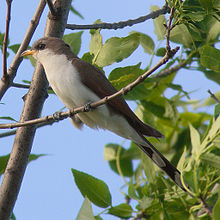Yellow-billed cuckoo
| Yellow-billed cuckoo Temporal range:
| |
|---|---|

| |
| Scientific classification | |
| Domain: | Eukaryota |
| Kingdom: | Animalia |
| Phylum: | Chordata |
| Class: | Aves |
| Order: | Cuculiformes
|
| Family: | Cuculidae |
| Genus: | Coccyzus |
| Species: | C. americanus
|
| Binomial name | |
| Coccyzus americanus | |

| |
| Synonyms | |
|
Cuculus americanus Linnaeus, 1758 | |

The yellow-billed cuckoo (Coccyzus americanus) is a member of the cuckoo family. Common folk names for this bird in the southern United States are rain crow and storm crow. These likely refer to the bird's habit of calling on hot days, often presaging rain or thunderstorms. The genus name is from the Ancient Greek kokkuzo, which means to call like a common cuckoo, and americanus means "of America".
Taxonomy
The yellow-billed cuckoo was
Description

Adults have a long tail, brown above and black-and-white below, and a black curved bill with yellow especially on the lower mandible. The head and upper parts are brown and the underparts are white. There is a yellow ring around the eye. It shows cinnamon on the wings in flight. Juveniles are similar, but the black on the undertail is replaced by gray.
Measurements:[7]
- Length: 10.2-11.8 in (26-30 cm)
- Weight: 1.9-2.3 oz (55-65 g)
- Wingspan: 15.0-16.9 in (38-43 cm)
Distribution and habitat
Their breeding habitat is deciduous woods from southern Canada to Mexico and the Caribbean. They migrate to Central America and as far south as northern Argentina. This bird is a rare vagrant in western Europe.
Behavior and ecology
Food and feeding
These birds forage in dense shrubs and trees and also may catch
Breeding
They nest in a tree or shrub, usually up to 2–12 feet (1–4 meters) above the ground. The nest is a flimsy platform of short twigs placed on a horizontal branch. The 3–4 eggs are incubated for 14 days or less. The chicks are able to climb about with agility at 7–9 days of age. At about this same time, the feathers of the chicks burst out of their sheaths and the young are able to fly. The entire time from egg-laying to fledging may be as little as 17 days. Yellow-billed cuckoos occasionally lay

Conservation status
There is an ongoing debate regarding the taxonomic status of the Western
References
- . Retrieved 11 November 2021.
- ^ Linnaeus, Carl (1758). Systema Naturae per regna tria naturae, secundum classes, ordines, genera, species, cum characteribus, differentiis, synonymis, locis (in Latin). Vol. 1 (10th ed.). Holmiae (Stockholm): Laurentii Salvii. p. 111.
- ^ Catesby, Mark (1729–1732). The Natural History of Carolina, Florida and the Bahama Islands (in English and French). Vol. 1. London: W. Innys and R. Manby. p. 9, Plate 9.
- ^ Vieillot, Louis Pierre (1816). Analyse d'une Nouvelle Ornithologie Élémentaire (in French). Paris: Deterville/self. p. 28.
- ^ Rasmussen, Pamela, eds. (January 2022). "Turacos, bustards, cuckoos, mesites, sandgrouse". IOC World Bird List Version 12.1. International Ornithologists' Union. Retrieved 13 August 2022.
- ISBN 978-1-4081-2501-4.
- ^ "Yellow-billed Cuckoo Identification, All About Birds, Cornell Lab of Ornithology". Allaboutbirds.org. Retrieved 26 September 2020.
- PMID 18959305.
- ^ "Yellow-Billed Cuckoo Species Account, Sacramento Fish & Wildlife Office". Fws.gov. Retrieved 15 March 2022.
- ^ "Biogeography of Western Yellow Billed Cuckoo". Bss.sfsu.edu. Retrieved 15 March 2022.
- ^ Fleischer, Robert C. "Taxonomic and Evolutionarily Significant Unit (ESU) Status of Western Yellow-billed Cuckoos (Coccyzus americanus)". Report to the USGS and USFWS.
- ^ "ECOS: Species Profile". Ecos.fws.gov. Retrieved 15 March 2022.
- ^ "Proposed Rules : Endangered and Threatened Wildlife and Plants; Revised Designation of Critical Habitat for the Western Distinct Population Segment of the Yellow Billed Cuckoo" (PDF). Federal Register. 85 (39). 27 February 2020. Retrieved 15 March 2022.
- ^ "Endangered and Threatened Wildlife and Plants; Designation of Critical Habitat for the Western Distinct Population Segment of the Yellow-Billed Cuckoo (Coccyzus americanus)". Federal Register. 2 December 2014. Retrieved 29 June 2018.
- ^ "Trump Administration Moves to Strip Endangered Species Protections From Threatened Western Songbird". Biologicaldiversity.org. Retrieved 29 June 2018.
- ^ "Proposed Rules : Endangered and Threatened Wildlife and Plants; Findings on a Petition To Delist the Distinct Population Segment of the Western Yellow-Billed Cuckoo" (PDF). Federal Register. 85 (180). 16 September 2020. Retrieved 15 March 2022.
Further reading
- John K. Terres (1980), Audubon Society Encyclopedia of North American Birds, Knopf, ISBN 0-394-46651-9
- David Gaines Review of the Status of the Yellow-Billed Cuckoo in California: Sacramento Valley Populations The Condor, Vol. 76, No. 2 (Summer, 1974), pp. 204–209
- Laymon, S.A., and M.D. Halterman. 1987. Can the western subspecies of Yellow-billed Cuckoo be saved from extinction? Western Birds 18:19-25.

